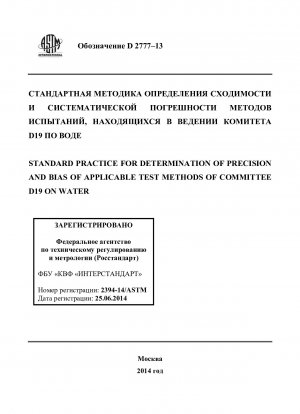ASTM D2777-13
Standard Practice for Determination of Precision and Bias of Applicable Test Methods of Committee D19 on Water
- Standard No.
- ASTM D2777-13
- Release Date
- 2013
- Published By
- American Society for Testing and Materials (ASTM)
- Status
- Replace By
- ASTM D2777-21
- Latest
- ASTM D2777-21
- Scope
5.1 Following this practice should result in precision-and-bias statements that can be achieved by any laboratory properly using the test method studied. These precision-and-bias statements provide the basis for generic limits for use in the Quality Control section of the test method. Optionally, the detection and quantitation values provide estimates of the level at which most laboratories should be able to achieve confident detection and meet the minimum precision (expressed as relative standard deviation) expected.
5.2 The method specifies the matrices for which the test method is appropriate. The collaborative test corroborates the write-up within the limitations of the test design. An extensive test can only use representative matrices so that universal applicability cannot be implied from the results.
5.3 The fundamental assumption of the collaborative study is that the matrices tested, the concentrations tested, and the participating laboratories are a representative and fair evaluation of the scope and applicability of the test method as written.
1.1 This practice establishes uniform standards for estimating and expressing the precision and bias of applicable test methods for Committee D19 on Water. Statements of precision and bias in test methods are required by the Form and Style for ASTM Standards, “Section A21. Precision and Bias (Mandatory).” In principle, all test methods are covered by this practice.
1.2 Except as specified in 1.4, 1.5, and 1.6, this practice requires the task group proposing a new test method to carry out a collaborative study from which statements for precision (overall and single-operator standard-deviation estimates) and bias can be developed. This practice provides general guidance to task groups in planning and conducting such determinations of precision and bias.
1.3 This practice also provides guidance to task groups for conducting limited-scale collaborative studies (known as “comparability studies”) for test methods that have been revised, when such revision includes substantive modifications. Examples of substantive modifications may include, but are not limited to, changes in mandatory or allowable instrumentation, reagents, reaction times, etc.
1.3.1 Changes to applicable water matrices in the Scope of a method may constitute a substantive modification under this provision. However, recognize that even the original collaborative study may not have used all the various matrix types specified in the method’s original Scope.
1.3.2 A method's concentration-range extension that is deemed to merit additional collaborative testing (even without a method modification that would otherwise be considered substantive) shall require a full collaborative study, as described in Sections 7.1-7.5, but only at Youden-pair concentrations representative of the extended range. Note that such a collaborative study could involve as little as a......
ASTM D2777-13 Referenced Document
- ASTM D1129 Standard Terminology Relating to Water
- ASTM D1141 Standard Practice for the Preparation of Substitute Ocean Water
- ASTM D1193 Standard Specification for Reagent Water
- ASTM D4375 Standard Practice for Basic Statistics in Committee D-19 on Water
- ASTM D5790 Standard Test Method for Measurement of Purgeable Organic Compounds in Water by Capillary Column Gas Chromatography/Mass Spectrometry
- ASTM D5847 Standard Practice for Writing Quality Control Specifications for Standard Test Methods for Water Analysis
- ASTM D5905 Standard Practice for the Preparation of Substitute Wastewater
- ASTM D6091 Standard Practice for 99 %/95 % Interlaboratory Detection Estimate (IDE) for Analytical Methods with Negligible Calibration Error
- ASTM D6512 Standard Practice for Interlaboratory Quantitation Estimate
- ASTM E1169 Standard Guide for Conducting Ruggedness Tests
- ASTM E177 Standard Practice for Use of the Terms Precision and Bias in ASTM Test Methods
- ASTM E178 Standard Practice for Dealing With Outlying Observations
- ASTM E456 Standard Terminology for Relating to Quality and Statistics
- ASTM E691 Standard Practice for Conducting an Interlaboratory Study to Determine the Precision of a Test Method
ASTM D2777-13 history
- 2021 ASTM D2777-21 Standard Practice for Determination of Precision and Bias of Applicable Test Methods of Committee D19 on Water
- 2013 ASTM D2777-13 Standard Practice for Determination of Precision and Bias of Applicable Test Methods of Committee D19 on Water
- 2012 ASTM D2777-12 Standard Practice for Determination of Precision and Bias of Applicable Test Methods of Committee D19 on Water
- 2008 ASTM D2777-08e1 Standard Practice for Determination of Precision and Bias of Applicable Test Methods of Committee D19 on Water
- 2008 ASTM D2777-08 Standard Practice for Determination of Precision and Bias of Applicable Test Methods of Committee D19 on Water
- 2006 ASTM D2777-06 Standard Practice for Determination of Precision and Bias of Applicable Test Methods of Committee D19 on Water
- 2003 ASTM D2777-03 Standard Practice for Determination of Precision and Bias of Applicable Methods of Committee D-19 on Water
- 1998 ASTM D2777-98 Standard Practice for Determination of Precision and Bias of Applicable Methods of Committee D-19 on Water

Copyright ©2024 All Rights Reserved